steering MERCEDES-BENZ ML SUV 2008 Service Manual
[x] Cancel search | Manufacturer: MERCEDES-BENZ, Model Year: 2008, Model line: ML SUV, Model: MERCEDES-BENZ ML SUV 2008Pages: 381, PDF Size: 7.18 MB
Page 235 of 381
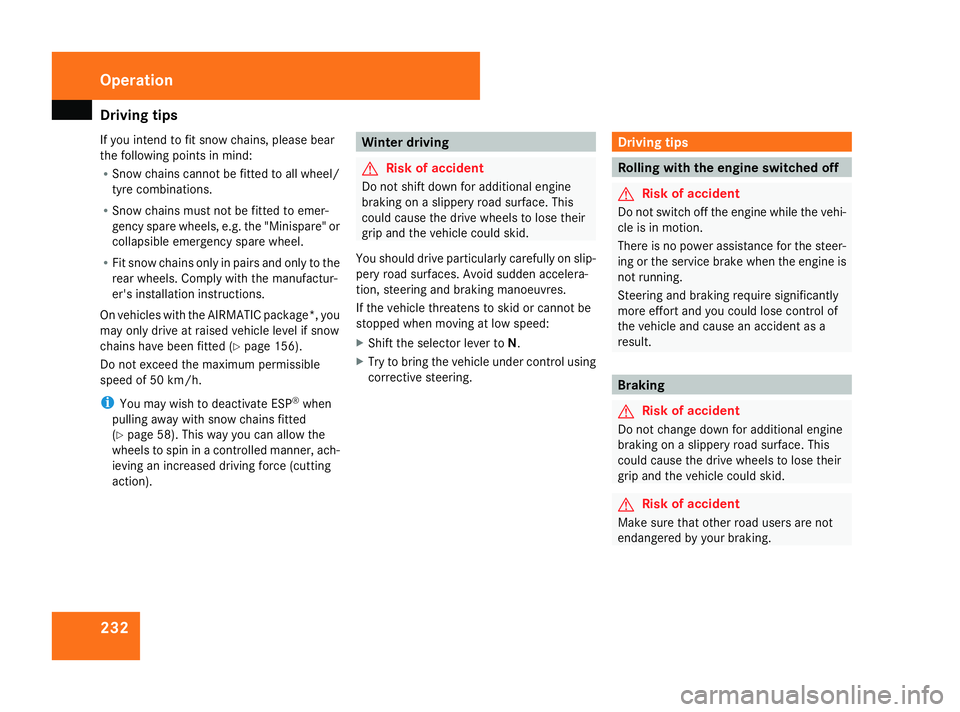
Driving
tips 232
If you intend to fit snow chains, please bear
the following points in mind:
R Snow chains cannot be fitted to all wheel/
tyre combinations.
R Snow chains must not be fitted to emer-
gency spare wheels, e.g. the "Minispare" or
collapsible emergency spare wheel.
R Fit snow chains only in pairs and only to the
rear wheels. Comply with the manufactur-
er's installation instructions.
On vehicles with the AIRMATIC package*, you
may only drive at raised vehicle level if snow
chains have been fitted (Y page 156).
Do not exceed the maximum permissible
speed of 50 km/h.
i You may wish to deactivate ESP ®
when
pulling away with snow chains fitted
(Y page 58). This way you can allow the
wheels to spin in a controlled manner, ach-
ieving an increased driving force (cutting
action). Winter driving
G
Risk of accident
Do not shift down for additional engine
braking on a slippery road surface. This
could cause the drive wheels to lose their
grip and the vehicle could skid.
You should drive particularly carefully on slip-
pery road surfaces. Avoid sudden accelera-
tion, steering and braking manoeuvres.
If the vehicle threatens to skid or cannot be
stopped when moving at low speed:
X Shift the selector lever to N.
X Try to bring the vehicle under control using
corrective steering. Driving tips
Rolling with the engine switched off
G
Risk of accident
Do not switch off the engine while the vehi-
cle is in motion.
There is no power assistance for the steer-
ing or the service brake when the engine is
not running.
Steering and braking require significantly
more effort and you could lose control of
the vehicle and cause an accident as a
result. Braking
G
Risk of accident
Do not change down for additional engine
braking on a slippery road surface. This
could cause the drive wheels to lose their
grip and the vehicle could skid. G
Risk of accident
Make sure that other road users are not
endangered by your braking. Operation
164_AKB; 5; 5, en-GB
wobuchh
,V ersion: 2.10.6
2008-05-11T11:55:12+02:00 - Seite 232 Dateiname: 6515_4293_02_buchblock.pdf; preflight
Page 239 of 381
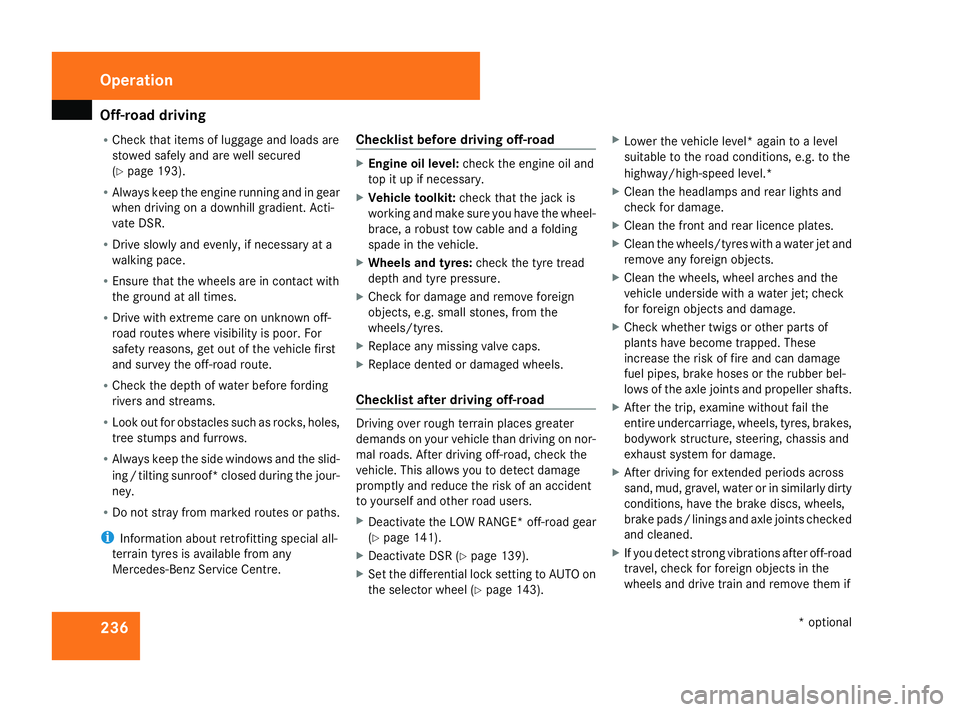
Off-road driving
236
R
Check that items of luggage and loads are
stowed safely and are well secured
(Y page 193).
R Always keep the engine running and in gear
when driving on a downhill gradient. Acti-
vate DSR.
R Drive slowly and evenly, if necessary at a
walking pace.
R Ensure that the wheels are in contact with
the ground at all times.
R Drive with extreme care on unknown off-
road routes where visibility is poor. For
safety reasons, get out of the vehicle first
and survey the off-road route.
R Check the depth of water before fording
rivers and streams.
R Look out for obstacles such as rocks, holes,
tree stumps and furrows.
R Always keep the side windows and the slid-
ing /tilting sunroof* closed during the jour-
ney.
R Do not stray from marked routes or paths.
i Information about retrofitting special all-
terrain tyres is available from any
Mercedes-Benz Service Centre. Checklist before driving off-road X
Engine oil level: check the engine oil and
top it up if necessary.
X Vehicle toolkit: check that the jack is
working and make sure you have the wheel-
brace, a robust tow cable and a folding
spade in the vehicle.
X Wheels and tyres: check the tyre tread
depth and tyre pressure.
X Check for damage and remove foreign
objects, e.g. small stones, from the
wheels/tyres.
X Replace any missing valve caps.
X Replace dented or damaged wheels.
Checklist after driving off-road Driving over rough terrain places greater
demands on your vehicle than driving on nor-
mal roads. After driving off-road, check the
vehicle. This allows you to detect damage
promptly and reduce the risk of an accident
to yourself and other road users.
X
Deactivate the LOW RANGE* off-road gear
(Y page 141).
X Deactivate DSR (Y page 139).
X Set the differential lock setting to AUTO on
the selector wheel (Y page 143). X
Lower the vehicle level* again to a level
suitable to the road conditions, e.g. to the
highway/high-speed level.*
X Clean the headlamps and rear lights and
check for damage.
X Clean the front and rear licence plates.
X Clean the wheels/tyres with a water jet and
remove any foreign objects.
X Clean the wheels, wheel arches and the
vehicle underside with a water jet; check
for foreign objects and damage.
X Check whether twigs or other parts of
plants have become trapped. These
increase the risk of fire and can damage
fuel pipes, brake hoses or the rubber bel-
lows of the axle joints and propeller shafts.
X After the trip, examine without fail the
entire undercarriage, wheels, tyres, brakes,
bodywork structure, steering, chassis and
exhaust system for damage.
X After driving for extended periods across
sand, mud, gravel, water or in similarly dirty
conditions, have the brake discs, wheels,
brake pads /linings and axle joints checked
and cleaned.
X If you detect strong vibrations after off-road
travel, check for foreign objects in the
wheels and drive train and remove them if Operation
* optional
164_AKB; 5; 5, en-GB
wobuchh,
Version: 2.10.6 2008-05-11T11:55:12+02:00 - Seite 236Dateiname: 6515_4293_02_buchblock.pdf; preflight
Page 247 of 381

Trailer towing*
244
!
A maximum speed of 80 km/h should not
be exceeded, even in countries where
higher speeds are permitted for vehicle/
trailer combinations.
When towing a trailer, your vehicle's handling
characteristics will be different in comparison
to when driving without a trailer.
The vehicle/trailer combination:
R is heavier
R is restricted in its acceleration and gradi-
ent-climbing capability
R has an increased braking distance
R is affected more by strong crosswinds
R demands more sensitive steering
R consumes more fuel
On long and steep downhill gradients you
must select the shift range 1,2or 3in good
time.
i This also applies if you have activated
cruise control, Distronic* or Speedtronic.
This uses the braking effect of the engine and
you will not have to brake to such an extent
to maintain the same speed. This relieves the
load on the brake system and prevents the
brakes from overheating and wearing too
quickly. If you need additional braking, depress the brake pedal repeatedly rather
than continuously. G
Risk of accident
Never depress the brake pedal continu-
ously while the vehicle is in motion, e.g.
never cause the brakes to rub by applying
constant slight pedal pressure. This causes
the brake system to overheat, increases
the braking distance and can lead to the
brakes failing completely.
Driving tips
R Maintain a greater distance from the vehi-
cle in front than when driving without a
trailer.
R Avoid braking abruptly. If possible, brake
gently at first to allow the trailer to run on.
Then increase the braking force rapidly.
R The values given for gradient-climbing
capabilities from a standstill refer to sea
level. When driving in mountainous areas,
note that the power output of the engine,
and consequently the vehicle's gradient-
climbing capability, decrease with increas-
ing altitude.
If the trailer swings from side to side: X
Do not accelerate.
X Do not counter-steer.
X Brake if necessary. G
Risk of accident
On no account should you attempt to draw
the vehicle/trailer combination out by
increasing speed. Folding in the ball coupling
i Fold in the ball coupling when you are not
using the trailer tow hitch. 1
Telescopic lever
2 Indicator lamp
X Place the protective cap on the ball cou-
pling. Operation
* optional
164_AKB; 5; 5, en-GB
wobuchh
,V ersion: 2.10.6
2008-05-11T11:55:12+02:00 - Seite 244 Dateiname: 6515_4293_02_buchblock.pdf; preflight
Page 253 of 381
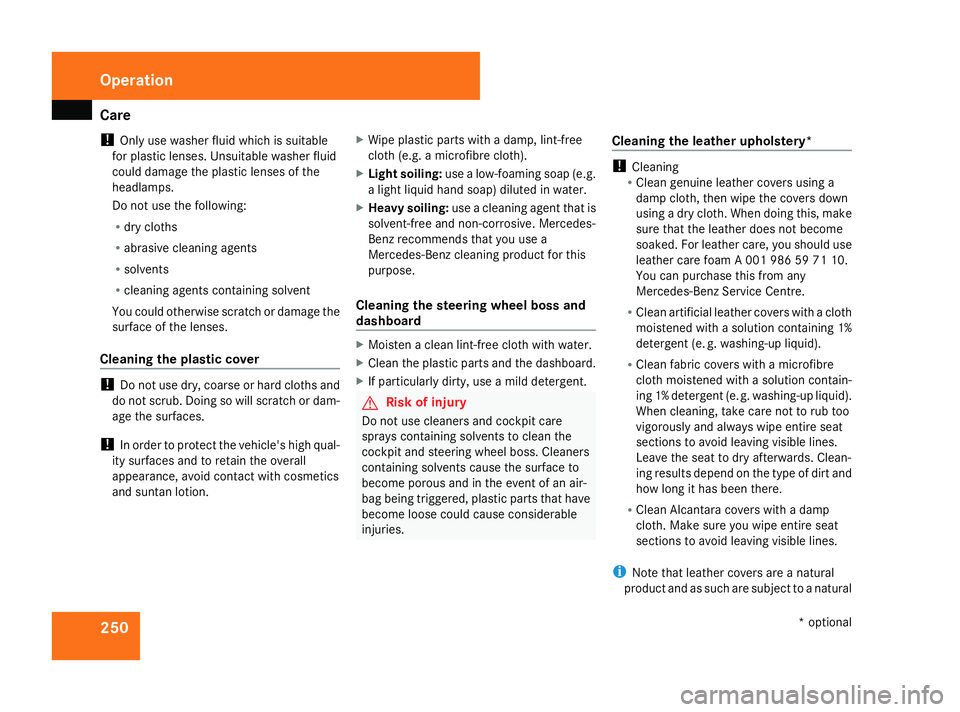
Care
250
!
Only use washer fluid which is suitable
for plastic lenses. Unsuitable washer fluid
could damage the plastic lenses of the
headlamps.
Do not use the following:
R dry cloths
R abrasive cleaning agents
R solvents
R cleaning agents containing solvent
You could otherwise scratch or damage the
surface of the lenses.
Cleaning the plastic cover !
Do not use dry, coarse or hard cloths and
do not scrub. Doing so will scratch or dam-
age the surfaces.
! In order to protect the vehicle's high qual-
ity surfaces and to retain the overall
appearance, avoid contact with cosmetics
and suntan lotion. X
Wipe plastic parts with a damp, lint-free
cloth (e.g. a microfibre cloth).
X Light soiling: use a low-foaming soap (e.g.
a light liquid hand soap) diluted in water.
X Heavy soiling: use a cleaning agent that is
solvent-free and non-corrosive. Mercedes-
Benz recommends that you use a
Mercedes-Benz cleaning product for this
purpose.
Cleaning the steering wheel boss and
dashboard X
Moisten a clean lint-free cloth with water.
X Clean the plastic parts and the dashboard.
X If particularly dirty, use a mild detergent. G
Risk of injury
Do not use cleaners and cockpit care
sprays containing solvents to clean the
cockpit and steering wheel boss. Cleaners
containing solvents cause the surface to
become porous and in the event of an air-
bag being triggered, plastic parts that have
become loose could cause considerable
injuries. Cleaning the leather upholstery* !
Cleaning
R Clean genuine leather covers using a
damp cloth, then wipe the covers down
using a dry cloth. When doing this, make
sure that the leather does not become
soaked. For leather care, you should use
leather care foam A 001 986 59 71 10.
You can purchase this from any
Mercedes-Benz Service Centre.
R Clean artificial leather covers with a cloth
moistened with a solution containing 1%
detergent (e. g. washing-up liquid).
R Clean fabric covers with a microfibre
cloth moistened with a solution contain-
ing 1% detergent (e. g. washing-up liquid).
When cleaning, take care not to rub too
vigorously and always wipe entire seat
sections to avoid leaving visible lines.
Leave the seat to dry afterwards. Clean-
ing results depend on the type of dirt and
how long it has been there.
R Clean Alcantara covers with a damp
cloth. Make sure you wipe entire seat
sections to avoid leaving visible lines.
i Note that leather covers are a natural
product and as such are subject to a natural Operation
* optional
164_AKB; 5; 5, en-GB
wobuchh,
Version: 2.10.6 2008-05-11T11:55:12+02:00 - Seite 250Dateiname: 6515_4293_02_buchblock.pdf; preflight
Page 270 of 381
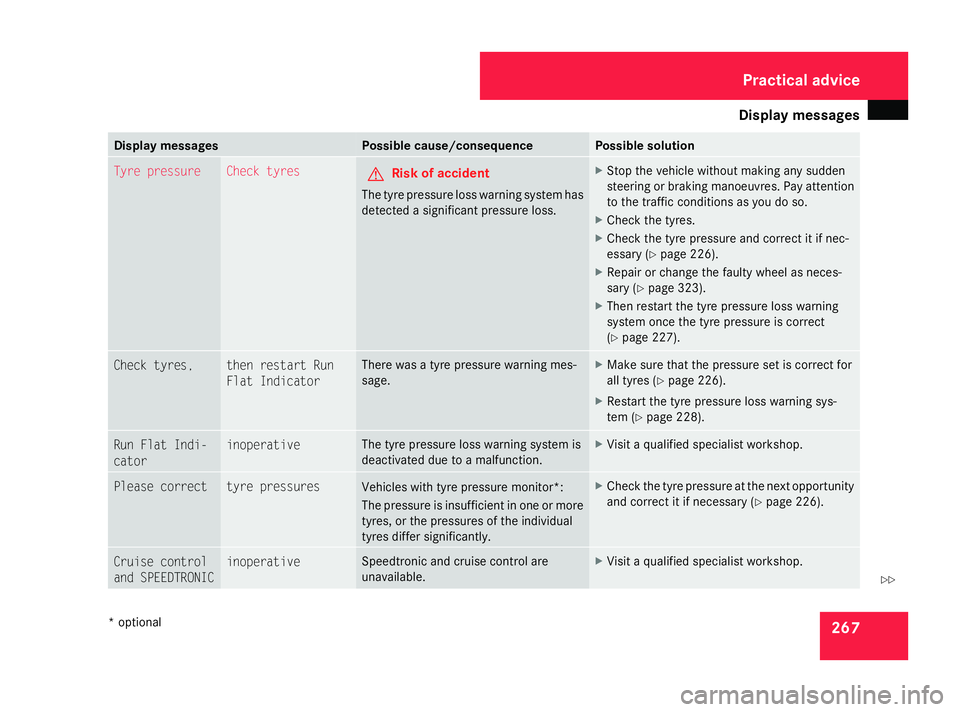
Display
messages 267Display messages Possible cause/consequence Possible solution
Tyre pressure Check tyres
G
Risk of accident
The tyre pressure loss warning system has
detected a significant pressure loss. X
Stop the vehicle without making any sudden
steering or braking manoeuvres. Pay attention
to the traffic conditions as you do so.
X Check the tyres.
X Check the tyre pressure and correct it if nec-
essary (Y page 226).
X Repair or change the faulty wheel as neces-
sary (Y page 323).
X Then restart the tyre pressure loss warning
system once the tyre pressure is correct
(Y page 227). Check tyres, then restart Run
Flat Indicator There was a tyre pressure warning mes-
sage. X
Make sure that the pressure set is correct for
all tyres (Y page 226).
X Restart the tyre pressure loss warning sys-
tem (Y page 228). Run Flat Indi-
cator inoperative The tyre pressure loss warning system is
deactivated due to a malfunction. X
Visit a qualified specialist workshop. Please correct tyre pressures
Vehicles with tyre pressure monitor*:
The pressure is insufficient in one or more
tyres, or the pressures of the individual
tyres differ significantly. X
Check the tyre pressure at the next opportunity
and correct it if necessary ( Ypage 226). Cruise control
and SPEEDTRONIC inoperative Speedtronic and cruise control are
unavailable. X
Visit a qualified specialist workshop. Practical advi
ce
* optional
164_AKB; 5; 5, en-GB
wobuchh,
Version: 2.10.6 2008-05-11T11:55:12+02:00 - Seite 267 ZDateiname: 6515_4293_02_buchblock.pdf; preflight
Page 275 of 381

Display
messages 272 Display messages Possible cause/consequence Possible solution
> Rising
20 km/h max. The vehicle is being adjusted to off-road
level 3. The display message indicates the
maximum speed allowed for off-road level
3. X
Do not exceed a maximum speed of 20 km/h. > 20 km/h max. You are driving in off-road level 3. The dis-
play message indicates the maximum
speed allowed for off-road level 3. X
Do not exceed a maximum speed of 20 km/h. p being lowered
20 km/h max. The vehicle is being lowered from off-road
level 3 to off-road level 2. The display mes-
sage indicates the maximum speed
allowed for off-road level 3. X
Do not drive faster than 20 km/h until the
vehicle has reached off-road level 2. p Bring speed below
20 km/h
G
Risk of accident
You are exceeding the speed permissible
for the selected off-road level. X
Do not exceed a maximum speed of 20 km/h.
X Adjust your driving style to the altered handling
characteristics.
X Avoid large steering angles and sudden steer-
ing movements.
X Be aware of the altered handling characteris-
tics. < Locking system
inoperative Con-
sult workshop There is a malfunction of the differential
locks.* X
Do not exceed a maximum speed of 80 km/h.
X Have the vehicle checked at a qualified spe-
cialist workshop. Practical advi
ce
* optional
164_AKB; 5; 5, en-GB
wobuchh,
Version: 2.10.6 2008-05-11T11:55:12+02:00 - Seite 272Dateiname: 6515_4293_02_buchblock.pdf; preflight
Page 284 of 381
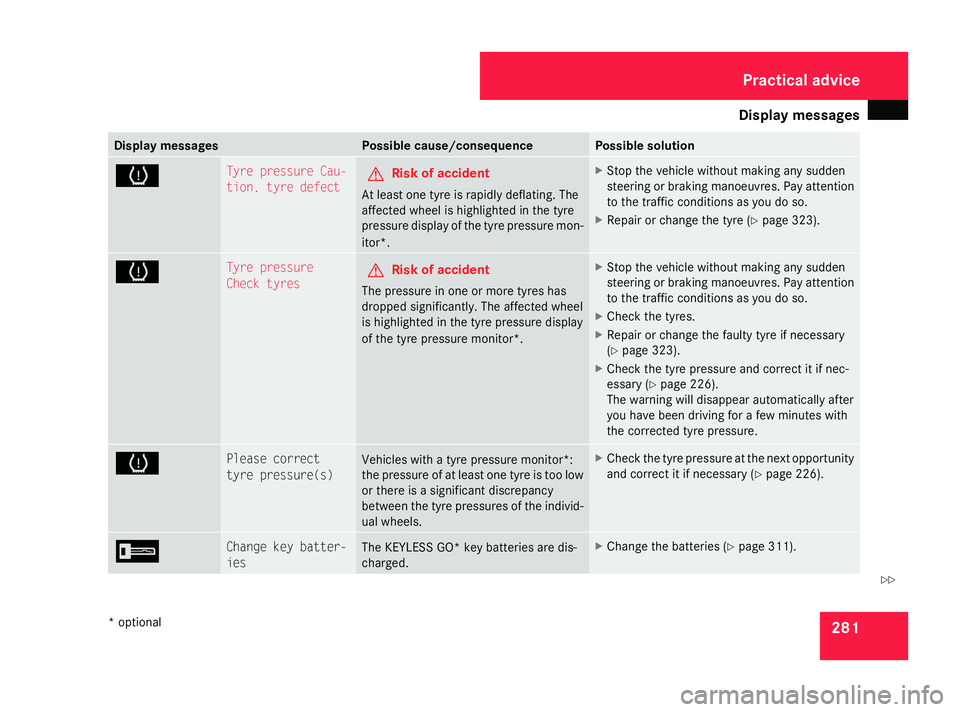
Display
messages 281Display messages Possible cause/consequence Possible solution
H Tyre pressure Cau-
tion, tyre defect G
Risk of accident
At least one tyre is rapidly deflating. The
affected wheel is highlighted in the tyre
pressure display of the tyre pressure mon-
itor*. X
Stop the vehicle without making any sudden
steering or braking manoeuvres. Pay attention
to the traffic conditions as you do so.
X Repair or change the tyre (Y page 323).H Tyre pressure
Check tyres G
Risk of accident
The pressure in one or more tyres has
dropped significantly. The affected wheel
is highlighted in the tyre pressure display
of the tyre pressure monitor*. X
Stop the vehicle without making any sudden
steering or braking manoeuvres. Pay attention
to the traffic conditions as you do so.
X Check the tyres.
X Repair or change the faulty tyre if necessary
(Y page 323).
X Check the tyre pressure and correct it if nec-
essary (Y page 226).
The warning will disappear automatically after
you have been driving for a few minutes with
the corrected tyre pressure. H Please correct
tyre pressure(s) Vehicles with a tyre pressure monitor*:
the pressure of at least one tyre is too low
or there is a significant discrepancy
between the tyre pressures of the individ-
ual wheels. X
Check the tyre pressure at the next opportunity
and correct it if necessary ( Ypage 226). I Change key batter-
ies The KEYLESS GO* key batteries are dis-
charged. X
Change the batteries (Y page 311). Practical advi
ce
* optional
164_AKB; 5; 5, en-GB
wobuchh,
Version: 2.10.6 2008-05-11T11:55:12+02:00 - Seite 281 ZDateiname: 6515_4293_02_buchblock.pdf; preflight
Page 289 of 381
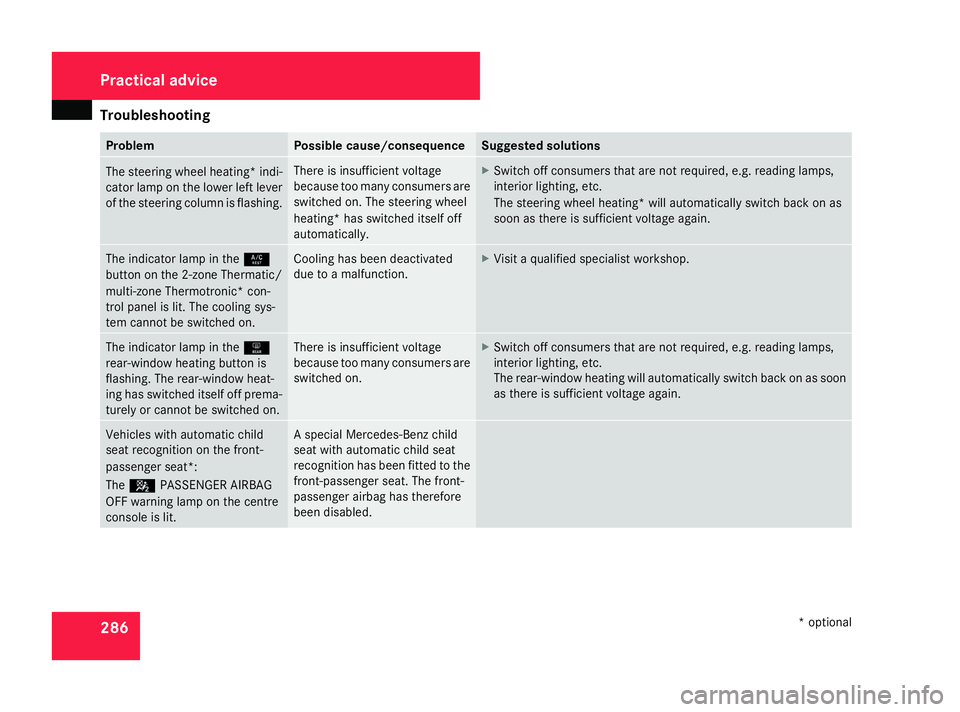
Troubleshooting
286 Problem Possible cause/consequence Suggested solutions
The steering wheel heating* indi-
cator lamp on the lower left lever
of the steering column is flashing. There is insufficient voltage
because too many consumers are
switched on. The steering wheel
heating* has switched itself off
automatically. X
Switch off consumers that are not required, e.g. reading lamps,
interior lighting, etc.
The steering wheel heating* will automatically switch back on as
soon as there is sufficient voltage again. The indicator lamp in the
9
button on the 2-zone Thermatic/
multi-zone Thermotronic* con-
trol panel is lit. The cooling sys-
tem cannot be switched on. Cooling has been deactivated
due to a malfunction. X
Visit a qualified specialist workshop. The indicator lamp in the
1
rear-window heating button is
flashing. The rear-window heat-
ing has switched itself off prema-
turely or cannot be switched on. There is insufficient voltage
because too many consumers are
switched on. X
Switch off consumers that are not required, e.g. reading lamps,
interior lighting, etc.
The rear-window heating will automatically switch back on as soon
as there is sufficient voltage again. Vehicles with automatic child
seat recognition on the front-
passenger seat*:
The
5 PASSENGER AIRBAG
OFF warning lamp on the centre
console is lit. A special Mercedes-Benz child
seat with automatic child seat
recognition has been fitted to the
front-passenger seat. The front-
passenger airbag has therefore
been disabled.Practical advice
* optional
164_AKB; 5; 5, en-GB
wobuchh
,V ersion: 2.10.6
2008-05-11T11:55:12+02:00 - Seite 286 Dateiname: 6515_4293_02_buchblock.pdf; preflight
Page 294 of 381
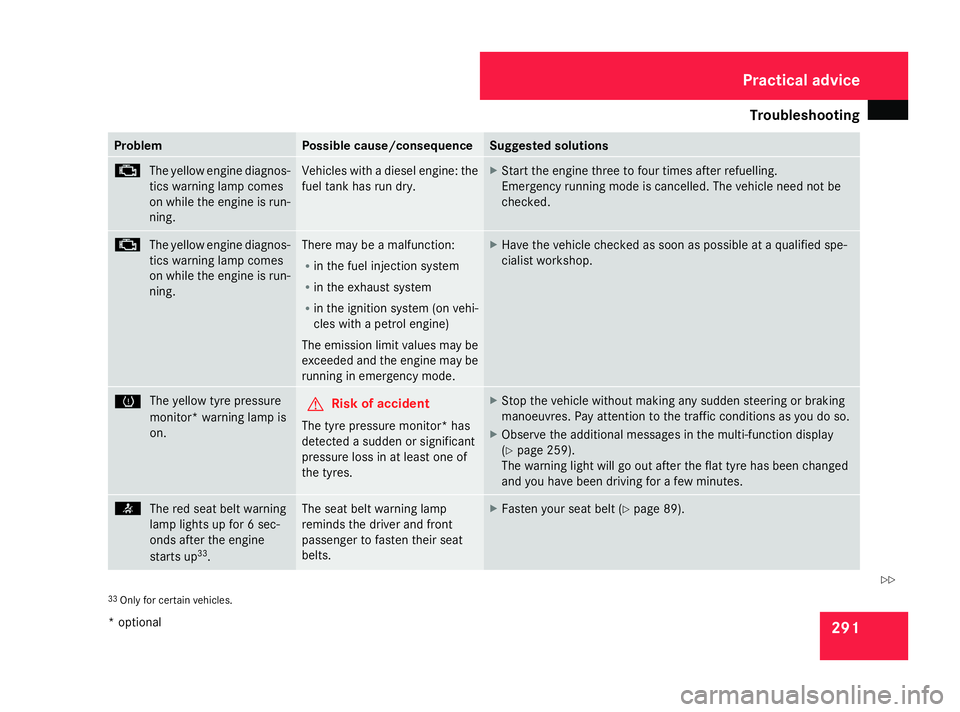
Troubleshooting
291Problem Possible cause/consequence Suggested solutions
±
The yellow engine diagnos-
tics warning lamp comes
on while the engine is run-
ning. Vehicles with a diesel engine: the
fuel tank has run dry. X
Start the engine three to four times after refuelling.
Emergency running mode is cancelled. The vehicle need not be
checked. ±
The yellow engine diagnos-
tics warning lamp comes
on while the engine is run-
ning. There may be a malfunction:
R
in the fuel injection system
R in the exhaust system
R in the ignition system (on vehi-
cles with a petrol engine)
The emission limit values may be
exceeded and the engine may be
running in emergency mode. X
Have the vehicle checked as soon as possible at a qualified spe-
cialist workshop. H
The yellow tyre pressure
monitor* warning lamp is
on. G
Risk of accident
The tyre pressure monitor* has
detected a sudden or significant
pressure loss in at least one of
the tyres. X
Stop the vehicle without making any sudden steering or braking
manoeuvres. Pay attention to the traffic conditions as you do so.
X Observe the additional messages in the multi-function display
(Y page 259).
The warning light will go out after the flat tyre has been changed
and you have been driving for a few minutes. <
The red seat belt warning
lamp lights up for 6 sec-
onds after the engine
starts up 33
. The seat belt warning lamp
reminds the driver and front
passenger to fasten their seat
belts. X
Fasten your seat belt (Y page 89).33
Only for certain vehicles. Practical advice
* optional
164_AKB; 5; 5, en-GB
wobuchh
,V ersion: 2.10.6
2008-05-11T11:55:12+02:00 - Seite 291 ZDateiname: 6515_4293_02_buchblock.pdf; preflight
Page 343 of 381
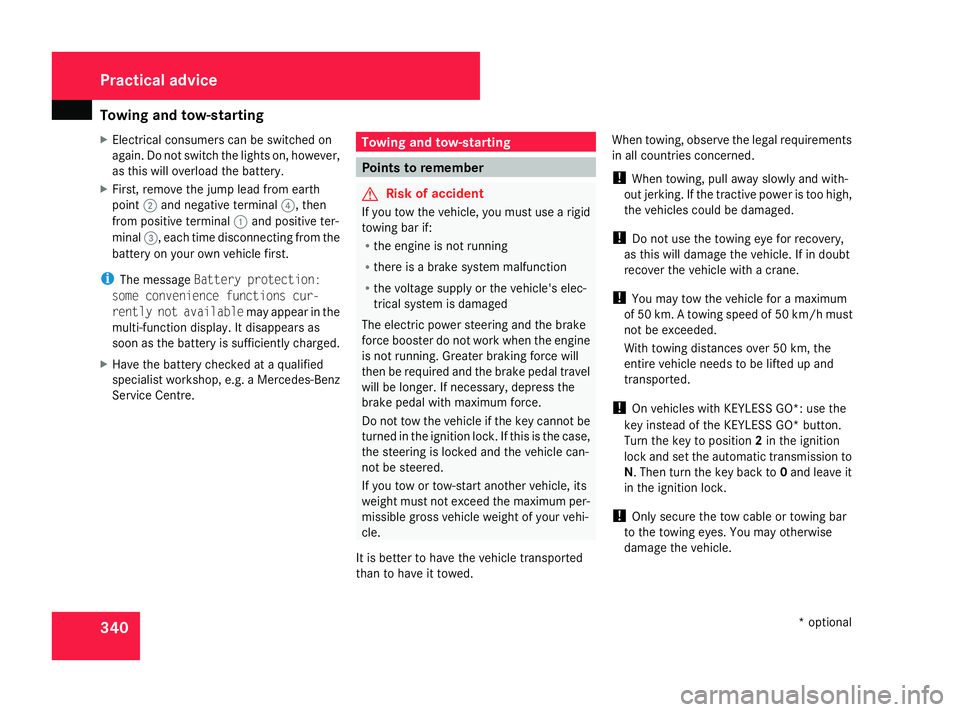
Towing and tow-starting
340
X
Electrical consumers can be switched on
again. Do not switch the lights on, however,
as this will overload the battery.
X First, remove the jump lead from earth
point 2and negative terminal 4, then
from positive terminal 1and positive ter-
minal 3, each time disconnecting from the
battery on your own vehicle first.
i The message Battery protection:
some convenience functions cur-
rently not available may appear in the
multi-function display. It disappears as
soon as the battery is sufficiently charged.
X Have the battery checked at a qualified
specialist workshop, e.g. a Mercedes-Benz
Service Centre. Towing and tow-starting
Points to remember
G
Risk of accident
If you tow the vehicle, you must use a rigid
towing bar if:
R the engine is not running
R there is a brake system malfunction
R the voltage supply or the vehicle's elec-
trical system is damaged
The electric power steering and the brake
force booster do not work when the engine
is not running. Greater braking force will
then be required and the brake pedal travel
will be longer. If necessary, depress the
brake pedal with maximum force.
Do not tow the vehicle if the key cannot be
turned in the ignition lock. If this is the case,
the steering is locked and the vehicle can-
not be steered.
If you tow or tow-start another vehicle, its
weight must not exceed the maximum per-
missible gross vehicle weight of your vehi-
cle.
It is better to have the vehicle transported
than to have it towed. When towing, observe the legal requirements
in all countries concerned.
!
When towing, pull away slowly and with-
out jerking. If the tractive power is too high,
the vehicles could be damaged.
! Do not use the towing eye for recovery,
as this will damage the vehicle. If in doubt
recover the vehicle with a crane.
! You may tow the vehicle for a maximum
of 50 km. A towing speed of 50 km/h must
not be exceeded.
With towing distances over 50 km, the
entire vehicle needs to be lifted up and
transported.
! On vehicles with KEYLESS GO*: use the
key instead of the KEYLESS GO * button.
Turn the key to position 2in the ignition
lock and set the automatic transmission to
N. Then turn the key back to 0and leave it
in the ignition lock.
! Only secure the tow cable or towing bar
to the towing eyes. You may otherwise
damage the vehicle. Practical advice
* optional
164_AKB; 5; 5, en-GB
wobuchh
,V ersion: 2.10.6
2008-05-11T11:55:12+02:00 - Seite 340 Dateiname: 6515_4293_02_buchblock.pdf; preflight